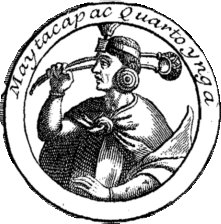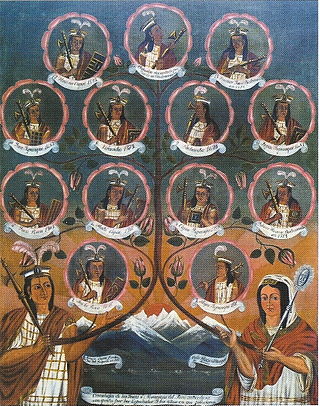
Cusco or Cuzco, is a city in southeastern Peru near the Urubamba Valley of the Andes mountain range. It is the capital of the Cusco Region and of the Cusco Province. The city is the seventh most populous in Peru; in 2017, it had a population of 428,450. Its elevation is around 3,400 m (11,200 ft).

Inca Garcilaso de la Vega, born Gómez Suárez de Figueroa and known as El Inca, was a chronicler and writer born in the Viceroyalty of Peru. Sailing to Spain at 21, he was educated informally there, where he lived and worked the rest of his life. The natural son of a Spanish conquistador and an Inca noblewoman born in the early years of the conquest, he is known primarily for his chronicles of Inca history, culture, and society. His work was widely read in Europe, influential and well received. It was the first literature by an author born in the Americas to enter the western canon.

A chasqui was a messenger of the Inca empire. Agile, highly trained and physically fit, they were in charge of carrying messages –in the form of quipus or oral information– and small packets. Along the Inca road system there were relay stations called chaskiwasi, placed at about 2.5 kilometres (1.6 mi) from each other, where the chasqui switched, exchanging their message(s) with the fresh messenger. The chasqui system could be able to deliver a message or a gift along a distance of up to 300 kilometres (190 mi) per day.

Inca education during the time of the Inca Empire was divided into two principal spheres: education for the upper classes and education for the general population. The royal classes and a few specially-chosen individuals from the provinces of the Empire were formally educated by the Amawtakuna (philosopher-scholars), while the general population were passed on knowledge and skills by their immediate forebears. Since the Incas did not have a written language, but instead had Quipus to record, it is difficult to determine the type of educational system the Incas did have.

Felipe Guamán Poma de Ayala, also known as Huamán Poma or Waman Poma, was a Quechua nobleman known for chronicling and denouncing the ill treatment of the natives of the Andes by the Spanish Empire after their conquest of Peru. Today, Guaman Poma is noted for his illustrated chronicle, El primer nueva corónica y buen gobierno.

Mayta Cápac was the fourth Sapa Inca of the Kingdom of Cuzco and a member of the Hurin dynasty.

The Wiphala is a square emblem commonly used as a flag to represent some native peoples of the Andes that include today's Peru, Bolivia, Chile, Ecuador, northwestern Argentina and southern Colombia.

Martín de Murúa, O. de M., was a Basque Mercedarian friar and chronicler of the Spanish conquest of the Americas. He is primarily known for his work Historia general del Piru, which is considered the earliest illustrated history of Peru.

Indian reductions in the Andes were settlements in the former Inca Empire created by Spanish authorities and populated by the forcible relocation of indigenous Andean populations, called "Indians" by the Spanish and "Andeans" by some modern scholars. The purpose of the Spanish Empire was to gather native populations into centers called "Indian reductions", to Christianize, tax, and govern them to comply with Spanish customs and economic interests.

The Incas were most notable for establishing the Inca Empire which was centered in modern day South America in Peru and Chile. It was about 2,500 miles from the northern to southern tip. The Inca Empire lasted from 1438 to 1533. It was the largest Empire in America throughout the Pre-Columbian era. At the peak of the Inca Empire, it was the largest nation in the world and to this day is the largest native state in the western hemisphere. The Inca civilization was located from north to south of the western hemisphere of South America. The Inca state was known as the Kingdom of Cuzco before 1438. Over the course of the Inca Empire, the Inca used conquest and peaceful assimilation to incorporate the territory of modern-day Peru, followed by a large portion of western South America, into their empire, centered on the Andean mountain range. However, shortly after the Inca Civil War, the last Sapa Inca (emperor) of the Inca Empire was captured and killed on the orders of the conquistador Francisco Pizarro, marking the beginning of Spanish rule. The remnants of the empire retreated to the remote jungles of Vilcabamba and established the small Neo-Inca State, which was conquered by the Spanish in 1572.
The term Peruvian literature not only refers to literature produced in the independent Republic of Peru, but also to literature produced in the Viceroyalty of Peru during the country's colonial period, and to oral artistic forms created by diverse ethnic groups that existed in the area during the prehispanic period, such as the Quechua, the Aymara and the Chanka South American native groups.

Coricancha, Koricancha, Qoricancha or Qorikancha was the most important temple in the Inca Empire. It is located in Cusco, Peru, which was the capital of the empire.

The Comentarios Reales de los Incas is a book written by Inca Garcilaso de la Vega, the first published mestizo writer of colonial Andean South America. The Comentarios Reales de los Incas is considered by most to be the unquestioned masterpiece of Inca Garcilaso de la Vega, born of the first generation after the Spanish conquest.

El primer nueva crónica y buen gobierno is a Peruvian chronicle finished around 1615. Its author, the indigenous Peruvian Felipe Guamán Poma de Ayala, sent it as a handwritten manuscript to King Philip III of Spain. His purpose was to give a historical account of the Andes from the earliest human beings to the Incas and the Spanish conquest; it was also meant as a call of attention towards the deep problems caused by Spanish government in the region.

Pedro de Candia was a Greek explorer and cartographer at the service of the Kingdom of Spain, an officer of the Royal Spanish Navy that under the Spanish Crown became a Conquistador, Grandee of Spain, Commander of the Royal Spanish Fleet of the Southern Sea, Colonial Ordinance of Cusco, and then Mayor of Lima between 1534 and 1535. Specialized in the use of firearms and artillery, he was one of the earliers explorers of Panama and the Pacific coastline of Colombia, and finally participated in the conquest of Peru. He was killed in the Battle of Chupas, (Peru), on 16 September 1542, by Diego de Almagro II.

Yanaca is a group of ancient, pre-Incan towns located in Peru in Apurimac Region, Aymaraes Province, Yanaca District. These towns were located in the area surrounding the present-day town of Yanaca in the Andes mountain range, between the Quechua and Suni regions.

The history of Cusco (Peru), the historical capital of the Incas.

Sabine Hyland is an American anthropologist and ethnohistorian working in the Andes. She is currently Professor of World Christianity at the University of St Andrews. She is best known for her work studying khipus and hybrid khipu-alphabetic texts in the Central Andes and is credited with the first potential phonetic decipherment of an element of a khipu. She has also written extensively about the interaction between Spanish missionaries and the Inca in colonial Peru, focusing on language, religion and missionary culture, as well as the history of the Chanka people.
Américo Mendoza Mori is a Peruvian scholar. He has contributed to the fields of Latin American Studies, Latino/a Studies, and Quechua languages. He teaches at Harvard University.
















